#progblr
Explore tagged Tumblr posts
Text
And this, ladies and gentlemen, is why I decided to just fuck everything about modern programming and start working primarily in DOS.
every software is like. your mission-critical app requires you to use the scrimble protocol to squeeb some snorble files for sprongle expressions. do you use:
libsnorble-2-dev, a C library that the author only distributes as source code and therefore must be compiled from source using CMake
Squeeb.js, which sort of has most of the features you want, but requires about a gigabyte of Node dependencies and has only been in development for eight months and has 4.7k open issues on Github
Squeeh.js, a typosquatting trojan that uses your GPU to mine crypto if you install it by mistake
Sprongloxide, a Rust crate beloved by its fanatical userbase, which has been in version 0.9.* for about four years, and is actually just a thin wrapper for libsnorble-2-dev
GNU Scrimble, a GPLv3-licensed command-line tool maintained by the Free Software Foundation, which has over a hundred different flags, and also comes with an integrated Lisp interpreter for scripting, and also a TUI-based Pong implementation as an "easter egg", and also supports CSV, XML, JSON, PDF, XLSX, and even HTML files, but does not actually come with support for squeebing snorble files for ideological reasons. it does have a boomeresque drawing of a grinning meerkat as its logo, though
Microsoft Scrimble Framework Core, a .NET library that has all the features you need and more, but costs $399 anually and comes with a proprietary licensing agreement that grants Microsoft the right to tattoo advertisements on the inside of your eyelids
snorblite, a full-featured Perl module which is entirely developed and maintained by a single guy who is completely insane and constantly makes blog posts about how much he hates the ATF and the "woke mind-virus", but everyone uses it because it has all the features you need and is distributed under the MIT license
Google Squeebular (deprecated since 2017)
6K notes
·
View notes
Text
Computers be like "omg bestie so true" and it's just the number 1
347 notes
·
View notes
Text
You, hey you. You right there. Amateur developer. Your stuff sucks right now doesn't it? Can't get a single project off the ground because you are still learning and you make a lot of dumb mistakes? And since you naturally want to be a good programmer, you want to start over and do it again but better?
Don't do that.
Whatever you have to do, I am BEGGING you. Finish that first project.
I want you to make it SUCK. I want the code to be a disaster. I want it to have bugs. I want it to have scrapped features that you just couldn't figure out. If you make it simple enough, a project held together with chewed gum and prayers, while not being a good or even competent it will be a finished one.
Why?
Because if you keep improving, but keep starting over. The logical end point is that you will be a good programmer with no finished projects. It's going to take YEARS. And eventually you will struggle to find motivation, burn out hard, take a SEVERAL month long break. Revaluate your whole life. And come to the stunning, crushing, horrifying realization that all those youtubers and influences you have watched that have told you to "start really really small". Were right.
Unfortunately, you are a good enough programmer that starting small isn't fun anymore. And actually FINISHING your first project is going to feel like pulling out your own teeth. And it's going to suck. And you are going to hate it.
And then you are going to attempt to warn others to skip all the hardship, tell them to start small. Start bad. Don't make the same mistake.
And hopefully, HOPEFULLY they will listen and go down the better path.
227 notes
·
View notes
Text
linux is just such a good special interest. it is a never ending hyperfixation; there is always a new rabbit hole to get lost in.
no matter how much i research, how much i read, i discover something new. i don't think i spent a day not learning ever since i made the switch years ago.
linux really tickles my autism in the best way.
#i fucking love linux so much#linux my beloved#blorbo from my computers#linuxposting#linuxblr#codeblr#progblr#autism#stemblr#actually autistic
165 notes
·
View notes
Text
Essentials You Need to Become a Web Developer
HTML, CSS, and JavaScript Mastery
Text Editor/Integrated Development Environment (IDE): Popular choices include Visual Studio Code, Sublime Text.
Version Control/Git: Platforms like GitHub, GitLab, and Bitbucket allow you to track changes, collaborate with others, and contribute to open-source projects.
Responsive Web Design Skills: Learn CSS frameworks like Bootstrap or Flexbox and master media queries
Understanding of Web Browsers: Familiarize yourself with browser developer tools for debugging and testing your code.
Front-End Frameworks: for example : React, Angular, or Vue.js are powerful tools for building dynamic and interactive web applications.
Back-End Development Skills: Understanding server-side programming languages (e.g., Node.js, Python, Ruby , php) and databases (e.g., MySQL, MongoDB)
Web Hosting and Deployment Knowledge: Platforms like Heroku, Vercel , Netlify, or AWS can help simplify this process.
Basic DevOps and CI/CD Understanding
Soft Skills and Problem-Solving: Effective communication, teamwork, and problem-solving skills
Confidence in Yourself: Confidence is a powerful asset. Believe in your abilities, and don't be afraid to take on challenging projects. The more you trust yourself, the more you'll be able to tackle complex coding tasks and overcome obstacles with determination.
#code#codeblr#css#html#javascript#java development company#python#studyblr#progblr#programming#comp sci#web design#web developers#web development#website design#webdev#website#tech#html css#learn to code
2K notes
·
View notes
Text
I made a beginner coding resource! 👩🏾💻💗


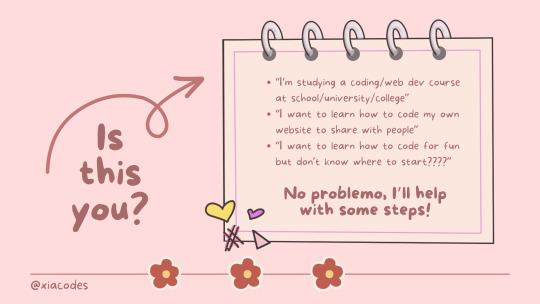
Hiya! 👩🏾💻💗
I made a coding infographic/slideshow for anyone getting into coding and are stuck! I'm seeing a lot of new codeblr blogs coming up recently and they're all beginners and I have been getting a lot of asks which basically all ask "I'm new to coding, how do I start?", so I decided to make this at 1am in the morning real quick! 🥲😭
I genuinely hope that this resource proves beneficial to someone out there. And remember, if you find yourself still facing challenges or need assistance with anything else, please don't hesitate to reach out. I'm here to help! ✨
Link to the PDF: LINK
#resources#my resources#codeblr#coding#progblr#programming#studyblr#studying#computer science#tech#study tips#compsci#studyblr community#cs studyblr#cs student#study aesthetic#pink study
2K notes
·
View notes
Text
#I bundled some together bc I had limited slots and wanted to make the best use of them#I would’ve liked to include more though#codeblr#progblr#linux#linuxposting#vi#vim#neovim#emacs#vscode#notepad++#sublime text#IntelliJ
143 notes
·
View notes
Text
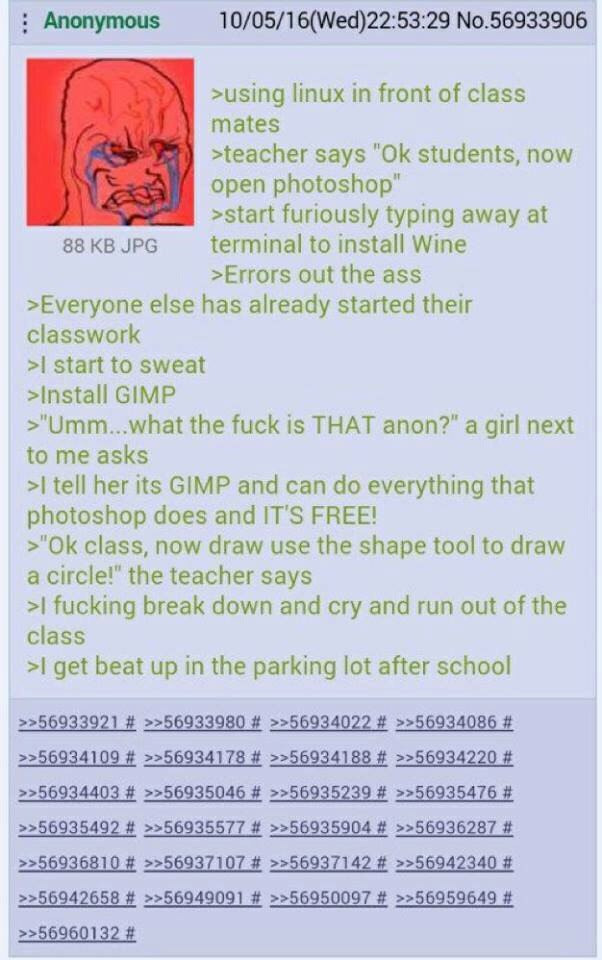
I think about this post every time i have some difficulties with my linux setup (basically daily)
#linux#codeblr#progblr#I'm going to the parking lot and beat up myself#is a catchphrase i started using a lot lately
2K notes
·
View notes
Text
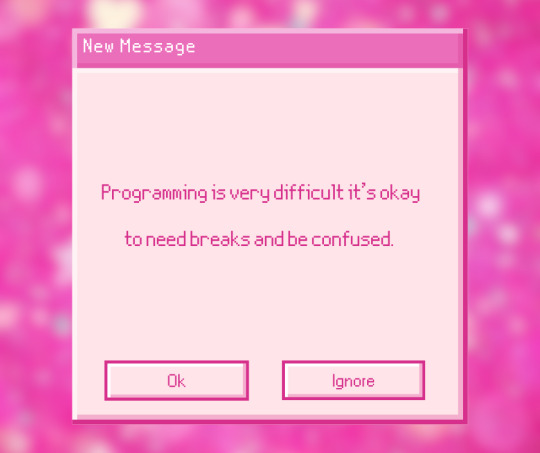
#gentle reminder#bunny makes blinkies#codeblr#coding#open folder: png#progblr#studyblr#css#programming#code blog#programming blog#programming blr#comp sci#computer science#2000s tech#pink#pink tech#pink aesthetic#old web#old tech#techcore#webcore
2K notes
·
View notes
Text
✧・゚: Customize your highlight color! :・゚✧
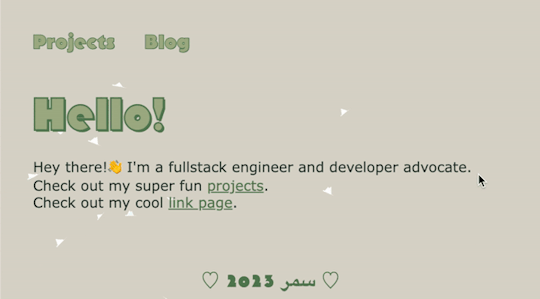
I recently came across a blog where when I went to highlight some text I noticed it was a unique color!!! (」°ロ°)」
AND IT'S SO SIMPLE TO DO
all you do is go to your css file and add this:
::selection { background: <hexcolor> }
Enjoy!! ♡⸜(˶˃ ᵕ ˂˶)⸝♡
#codeblr#progblr#programming#tech#coding#resources#frontend#studyblr#aesthetic#css#html#these little details make me so very happy#css tips
2K notes
·
View notes
Text
Me: *sighs* i dont know whats wrong with the code
Me: *looks at my Rubber Duck*
Me: Do you know what the problem is?
Sir Duckington:
Me, looking back at the code and sees the problem: What the fuck
168 notes
·
View notes
Text



habits i should try to avoid burnout 🍵
to varying degrees, every semester i burn out. this one may become the worst i've had in recent years if i'm not careful bc of the way i'm trying to pack my schedule. anxiety has been unexpectedly high this week and it's only week 1! 😖
🐢 self-care:
get 8-10 hours of sleep daily
daily exercise - enough to get me physically tired enough to sleep
meditate AND journal daily
give myself at least one day a week to chill (probably will be a "reset" day bc i can't just vegetable and expect my brain to not self-destruct. for now, let's try saturdays.)
more quality time with the people i love throughout the week
fresh air + sunlight when the weather isn't too inhospitable
no phone mornings (i quickly fell out of the habit but it did wonders for my mental health 😭)
🐰 time management:
set reasonable goals. don't kid yourself into thinking you can complete everything on a to-do list you doubt you can finish even half of - if you doubt, you're probably right.
take plenty of breaks throughout the day
don't procrastinate bc procrastination's consequences will definitely lead to burnout. on the days you just don't feel it, give yourself a reason to study that speaks to you. what is demotivating you? give yourself the encouragement you need to not give up.
vary the order in which you do things so your days feel like they have more variety (e.g. vary the order in which you work on different subjects every day)
study based on energy level (i.e. try to study high-energy subjects when you have high energy and low-energy subjects when you have low energy. stop for the day when you're just not there anymore, don't try to push it.) this doesn't have to be contradictory to the point above cuz i still have lots of choices for what to do and my energy sometimes fluctuates like crazy throughout a single day.
#🍵#burnout#studyblr#studyspo#study tips#study advice#self care#time management#self improvement#becoming that girl#study motivation#procrastination#student life#stemblr#premedblr#codeblr#progblr#100dop#mathblr#study aesthetic#beige aesthetic#light academia#light academia aesthetic#romantic academia#classic academia
599 notes
·
View notes
Text
tgirls be like
*most dick-suckingest voice you've ever heard* so yeah, even though Rust's syntax and runtime implementation details take inspiration from C++, its type system is actually primarily based on ML-family languages, completely breaking with the legacy of C. in fact, its first compiler was written in OCaml
120 notes
·
View notes
Text
what causes foss developers to give their programs the least pronounceable name they could think of? what is their goal??
68 notes
·
View notes
Text

Welcome back, coding enthusiasts! Today we'll talk about Git & Github , the must-know duo for any modern developer. Whether you're just starting out or need a refresher, this guide will walk you through everything from setup to intermediate-level use. Let’s jump in!
What is Git?
Git is a version control system. It helps you as a developer:
Track changes in your codebase, so if anything breaks, you can go back to a previous version. (Trust me, this happens more often than you’d think!)
Collaborate with others : whether you're working on a team project or contributing to an open-source repo, Git helps manage multiple versions of a project.
In short, Git allows you to work smarter, not harder. Developers who aren't familiar with the basics of Git? Let’s just say they’re missing a key tool in their toolkit.
What is Github ?
GitHub is a web-based platform that uses Git for version control and collaboration. It provides an interface to manage your repositories, track bugs, request new features, and much more. Think of it as a place where your Git repositories live, and where real teamwork happens. You can collaborate, share your code, and contribute to other projects, all while keeping everything well-organized.
Git & Github : not the same thing !
Git is the tool you use to create repositories and manage code on your local machine while GitHub is the platform where you host those repositories and collaborate with others. You can also host Git repositories on other platforms like GitLab and BitBucket, but GitHub is the most popular.
Installing Git (Windows, Linux, and macOS Users)
You can go ahead and download Git for your platform from (git-scm.com)
Using Git
You can use Git either through the command line (Terminal) or through a GUI. However, as a developer, it’s highly recommended to learn the terminal approach. Why? Because it’s more efficient, and understanding the commands will give you a better grasp of how Git works under the hood.
GitWorkflow
Git operates in several key areas:
Working directory (on your local machine)
Staging area (where changes are prepared to be committed)
Local repository (stored in the hidden .git directory in your project)
Remote repository (the version of the project stored on GitHub or other hosting platforms)
Let’s look at the basic commands that move code between these areas:
git init: Initializes a Git repository in your project directory, creating the .git folder.
git add: Adds your files to the staging area, where they’re prepared for committing.
git commit: Commits your staged files to your local repository.
git log: Shows the history of commits.
git push: Pushes your changes to the remote repository (like GitHub).
git pull: Pulls changes from the remote repository into your working directory.
git clone: Clones a remote repository to your local machine, maintaining the connection to the remote repo.
Branching and merging
When working in a team, it’s important to never mess up the main branch (often called master or main). This is the core of your project, and it's essential to keep it stable.
To do this, we branch out for new features or bug fixes. This way, you can make changes without affecting the main project until you’re ready to merge. Only merge your work back into the main branch once you're confident that it’s ready to go.
Getting Started: From Installation to Intermediate
Now, let’s go step-by-step through the process of using Git and GitHub from installation to pushing your first project.
Configuring Git
After installing Git, you’ll need to tell Git your name and email. This helps Git keep track of who made each change. To do this, run:

Master vs. Main Branch
By default, Git used to name the default branch master, but GitHub switched it to main for inclusivity reasons. To avoid confusion, check your default branch:

Pushing Changes to GitHub
Let’s go through an example of pushing your changes to GitHub.
First, initialize Git in your project directory:

Then to get the ‘untracked files’ , the files that we haven’t added yet to our staging area , we run the command

Now that you’ve guessed it we’re gonna run the git add command , you can add your files individually by running git add name or all at once like I did here

And finally it's time to commit our file to the local repository

Now, create a new repository on GitHub (it’s easy , just follow these instructions along with me)
Assuming you already created your github account you’ll go to this link and change username by your actual username : https://github.com/username?tab=repositories , then follow these instructions :


You can add a name and choose wether you repo can be public or private for now and forget about everything else for now.

Once your repository created on github , you’ll get this :

As you might’ve noticed, we’ve already run all these commands , all what’s left for us to do is to push our files from our local repository to our remote repository , so let’s go ahead and do that

And just like this we have successfully pushed our files to the remote repository
Here, you can see the default branch main, the total number of branches, your latest commit message along with how long ago it was made, and the number of commits you've made on that branch.

Now what is a Readme file ?
A README file is a markdown file where you can add any relevant information about your code or the specific functionality in a particular branch—since each branch can have its own README.
It also serves as a guide for anyone who clones your repository, showing them exactly how to use it.
You can add a README from this button:

Or, you can create it using a command and push it manually:

But for the sake of demonstrating how to pull content from a remote repository, we’re going with the first option:

Once that’s done, it gets added to the repository just like any other file—with a commit message and timestamp.
However, the README file isn’t on my local machine yet, so I’ll run the git pull command:

Now everything is up to date. And this is just the tiniest example of how you can pull content from your remote repository.
What is .gitignore file ?
Sometimes, you don’t want to push everything to GitHub—especially sensitive files like environment variables or API keys. These shouldn’t be shared publicly. In fact, GitHub might even send you a warning email if you do:

To avoid this, you should create a .gitignore file, like this:

Any file listed in .gitignore will not be pushed to GitHub. So you’re all set!
Cloning
When you want to copy a GitHub repository to your local machine (aka "clone" it), you have two main options:
Clone using HTTPS: This is the most straightforward method. You just copy the HTTPS link from GitHub and run:

It's simple, doesn’t require extra setup, and works well for most users. But each time you push or pull, GitHub may ask for your username and password (or personal access token if you've enabled 2FA).
But if you wanna clone using ssh , you’ll need to know a bit more about ssh keys , so let’s talk about that.
Clone using SSH (Secure Shell): This method uses SSH keys for authentication. Once set up, it’s more secure and doesn't prompt you for credentials every time. Here's how it works:
So what is an SSH key, actually?
Think of SSH keys as a digital handshake between your computer and GitHub.
Your computer generates a key pair:
A private key (stored safely on your machine)
A public key (shared with GitHub)
When you try to access GitHub via SSH, GitHub checks if the public key you've registered matches the private key on your machine.
If they match, you're in — no password prompts needed.
Steps to set up SSH with GitHub:
Generate your SSH key:

2. Start the SSH agent and add your key:

3. Copy your public key:

Then copy the output to your clipboard.
Add it to your GitHub account:
Go to GitHub → Settings → SSH and GPG keys
Click New SSH key
Paste your public key and save.
5. Now you'll be able to clone using SSH like this:

From now on, any interaction with GitHub over SSH will just work — no password typing, just smooth encrypted magic.
And there you have it ! Until next time — happy coding, and may your merges always be conflict-free! ✨👩💻👨💻
#code#codeblr#css#html#javascript#java development company#python#studyblr#progblr#programming#comp sci#web design#web developers#web development#website design#webdev#website#tech#html css#learn to code#github
54 notes
·
View notes
Text
How to learn: HTML | Resources ✨
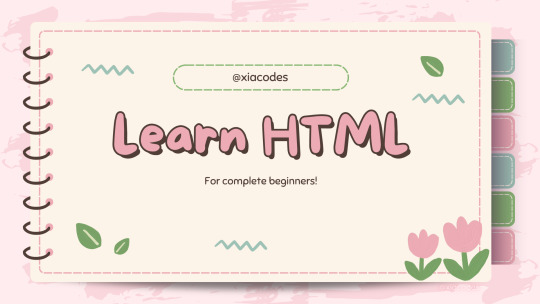

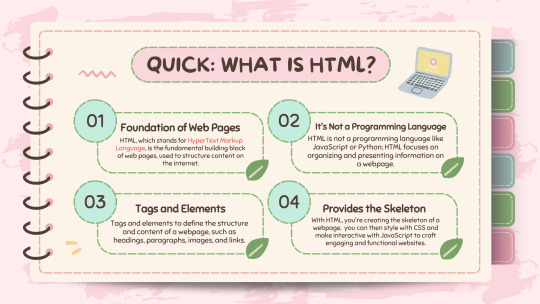
Sunday 10th September 2023
I have come back with a new resource I've made! This time about how to learn HTML! I'm starting from the basics right now and working my way up of 'how to learn' info resources!😅
I've made a HTML resource in the past (one | two) but this one is a bit more detailed and has tips of how I studied HTML. I use HTML on the daily so though I would share my knowledge with more people. Again, just like my previous resource "Starting your coding journey", this is more targeted towards absolute beginners or for people who want to learn how to customise their Tumblr blog/Neocite! 👩🏾💻
Anyhoo, check it out and let me know what you think: LINK
#my resources#resources#codeblr#coding#progblr#programming#studyblr#studying#computer science#tech#neocities#programmer#comp sci#study tips#compsci#studyblr community#cs studyblr#cs student#study aesthetic#pink study
2K notes
·
View notes